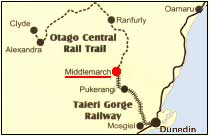| Rail Trail and Children |
The Rail Trail is suitable for a family experience and as such for any child who is keen on biking and uses a 16 inch bike or bigger with no trainer wheels.
The stretches between Tiroiti and Rock & Pillar do have some areas, where heavy ballast remains on the trail, and this can cause a few problems for children on smaller-wheeled bikes. As long as they are keen and encouraged, the ride is worthwhile. The gradient is fairly even all the way and therefore does not cause the problems of hill climbs.
The Rail Trail is the access way to Central Otago and share the hot summer climate. Remember sunblock and plenty of liquid (there are few watering spots along the way).
Riding is suitable all year round, except through snow. There are no sheltered points along the way yet, and on a hot day riding in the morning or late afternoon is recommended.
To the top
|
|
Origins of the Rail Trail
|
150 km of the former railway line from Middlemarch to Clyde was acquired by the Department of Conservation in 1993 for redevelopment as a recreational facility for walkers, cyclists and horse riders. The former railway was renamed the Otago Central Rail Trail. The Rail Trail is modelled on Rails to Trails projects elsewhere in the world. It took 6 years of development and $850,000 to upgrade the closed railway to its current standard. Over 60 bridges, several over 1 00m in length, were redecked and have had hand rails erected to make them safe for Rail Trail users. The crushed rock ballast of the railway foundation has been removed to improve the surface for users. The Rail Trail is now a unique recreational facility within New Zealand. It has also preserved, largely intact, an important part of Otago's history.
In the days before the railway it could take two days by coach from Dunedin to reach the Central Otago towns. Goods and supplies, which had to come by wagon, took much longer as a days travel for a wagon was seldom more than 30 kilometres.
From the early 1 870s there were calls for a railway to be built to Central Otago. There was general agreement on the need for the railway but there was much argument over which route it should take. In 1877 a government report reviewed seven possible routes:
- Kingston to Cromwell, via Frankton,
- Waipahi to Cromwell, via Roxburgh
- Lawrence to Cromwell, via the Clutha valley
- North Taieri to Cromwell, via the Strath Taieri
- Palmerston to Cromwell, via Macraes Flat
- Palmerston to Cromwell, via Shag Valley
- Oamaru to Cromwell, via Dansey's Pass
The Strath Taieri route was adopted because it crossed a minimum of rough country and allowed access to the largest area of Crown land available for settlement.
Construction began with a ceremony on June 7 1879. Vincent Pyke, former goldfields warden and the Member of Parliament for Dunstan, had the honour of turning the first sod in a ceremony at Wingatui, near Dunedin. Construction of the line was slow. It took 6 years to complete the first 12.5 km. It wasn't until January 1891 that the line reached Middlemarch, a distance of 64 km. The remaining 150 km of line to Clyde was opened in April 1907. Between 1914 and 1921 the line was extended to Cromwell.
Almost all the construction work (apart from bridge contracts) on the line between Middlemarch and Cromwell was carried out under a cooperative system. Under this system, workmen formed themselves into parties of 10 - 12, one of whom was elected the head man. Construction work was broken into sections and the engineer assessed the value of the work to be done on each section. The men were paid monthly; each man receiving a proportion of the total money based on the hours they worked. Construction camps were set up along the railway for the workmen and their families. Schools, stores and boarding houses were built along the line to cater to the needs of the inhabitants of the camps. These camps were periodically shifted along the line to keep pace with the construction.
Once completed the railway carried both passengers and freight. Fruit, livestock and wool were major freight items. After World War Two passenger numbers declined as private car usage increased. Up until 1961 the transporting of freight by trucks further than 48 km was prevented by government regulation to protect the railways from competition. In 1961 the restriction was relaxed to 64 km and restrictions on hauling livestock by road were entirely removed. In 1977 the limit was relaxed to 150 km and in 1983 all restrictions were removed.
Once this happened the end of the Central Otago line was certain. The line from Clyde to Cromwell was closed in 1980. Due to the construction of the Clyde dam the line to Clyde remained open through the 1980s. Construction work on the dam began to wind down in 1988 and the decision was taken to close the line in April 1990. The last train left the Clyde station on 29 April 1990. The tracks between Clyde and Middlemarch were removed during 1991. The remaining section of line from Wingatui to Middlemarch was purchased by the Dunedin City Council and is operated as a tourist venture by the .
To the top
|




